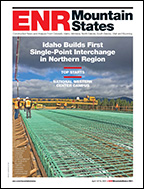Sizable Improvements
The job's complexity makes daily meetings a must. Major enhancements include a redesigned SH 114/121 interchange that will create a new one-mile-long direct connection into the five-terminal, 155-gate DFW International Airport. SH 121 and International Parkway are being merged into a three-lane airport entrance.
New continuous three-lane frontage roads are being built along westbound and eastbound SH 114 between Texan Trail Road and Northwest Highway, with an added green lane for bicycles along the frontage roads. Two new direct connectors will take northbound SH 121 traffic to westbound SH 114, and eastbound SH 114 traffic to southbound SH 121.
In addition, project enhancements place four miles of two-lane toll roads along SH 114 with electronic collections that keep traffic flowing at least 50 miles per hour. Traffic volumes and speeds will dictate tolls within each peak period, TxDOT says, although modeling suggests average rates of 16 cents per mile. Tolls are expected to eventually reach 24 cents per mile by 2029. Collected tolls will go toward highway operation and maintenance, TxDOT says.
The connector consists of more than three dozen bridges, including four intersection bridges through Grapevine and Southlake and 10 cross-street bridges. The 31-span, 3,700-ft-long eastbound SH 114 to southbound SH 121 flyover is the job's longest bridge and features steel-girder concrete deck structure.
General travel lanes are being added throughout the corridor, although capacity varies depending upon location. There will be four to six lanes along SH 114 between SH 1709 and William D. Tate Avenue, but four to seven northbound lanes and three to six southbound lanes are being created along SH 121 between the north entrance to DFW Airport and Interstate-635. At the widest point, along SH 114 between Texan Trail Road and International Parkway, the highway corridor will be more than 24 lanes wide.
Cruise Control
Despite the large scope, the project has been aided so far by good weather and an integrated partnering approach. Plenty of right-of-way room along the corridor also allowed for easy onsite staging and storage where needed. To limit downtime, NorthGate, which is self-performing the bulk of the work, is using an onsite concrete batch plant and temporary maintenance building.
"This team has a comprehensive understanding of the project's technical elements," says NorthGate deputy project director Rob Anderson. "The design and construction challenges associated with this work demanded close attention to stakeholder concerns when developing technical solutions."
Some solutions include a stormwater management plan with rock filter dams, silt fences and silt socks filled with 100% recyclable, biodegradable materials. NorthGate additionally inspects bridges and trees for active bird nests prior to demolition. The joint venture also will plant 700 trees throughout the connector upon completion. Nighttime work helps to mitigate traffic impacts and air pollution. NorthGate, which is running two shifts a day, has a three-to-five-minute idle policy for construction equipment to reduce waste while improving air quality.





Post a comment to this article
Report Abusive Comment